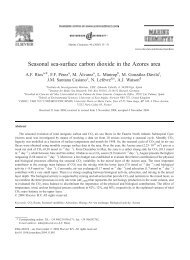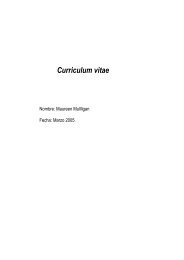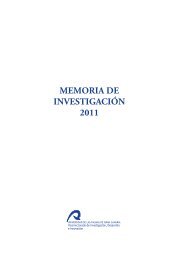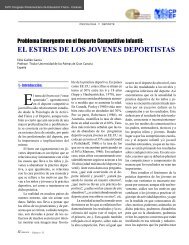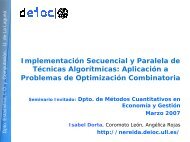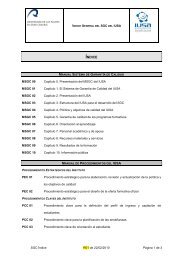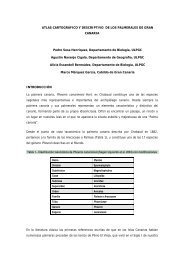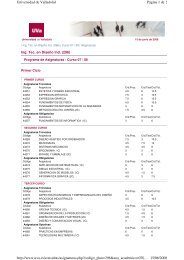article in press - ulpgc
article in press - ulpgc
article in press - ulpgc
Create successful ePaper yourself
Turn your PDF publications into a flip-book with our unique Google optimized e-Paper software.
INSUMA: 1064 + Model pp. 1–7 (col. fig: NIL)<br />
ARTICLE IN PRESS<br />
Insurance Mathematics and Economics xx (xxxx) xxx–xxx<br />
www.elsevier.com/locate/ime<br />
On the use of posterior regret Γ -m<strong>in</strong>imax actions to obta<strong>in</strong><br />
credibility premiums<br />
E. Gómez-Déniz a,∗ , J.M. Pérez-Sánchez b , F.J. Vázquez-Polo a<br />
a Department of Quantitative Methods, University of Las Palmas de Gran Canaria, 35017-Las Palmas de Gran Canaria, Spa<strong>in</strong><br />
b Department of Quantitative Methods <strong>in</strong> Economics, University of Granada, 18011-Granada, Spa<strong>in</strong><br />
Received January 2005; received <strong>in</strong> revised form January 2006; accepted 26 January 2006<br />
Abstract 3<br />
Comput<strong>in</strong>g premiums <strong>in</strong> a Bayesian context requires the use of a prior distribution that the unknown risk parameter follows 4<br />
<strong>in</strong> the heterogeneous portfolio. Follow<strong>in</strong>g the methodology that an actuary only has vague <strong>in</strong>formation about this parameter and 5<br />
therefore is unable to specify a simple prior, we choose a class Γ of priors and compute posterior regret Γ -m<strong>in</strong>imax premiums 6<br />
which can be written, under appropriate likelihoods and priors, as a credibility formula. 7<br />
c○ 2006 Elsevier B.V. All rights reserved. 8<br />
JEL classification: C11<br />
IM classification: IM30<br />
Keywords: Bayesian methodology; Posterior regret Γ -m<strong>in</strong>imax; Classes of prior distributions<br />
1. Introduction 10<br />
This <strong>article</strong> deals with the problem of estimat<strong>in</strong>g the Bayes premium when knowledge of the prior distribution is 11<br />
restricted to the fact that it is a member of a family Γ of prior distributions. In practice, prior knowledge is often vague 12<br />
and any elicited prior distribution is only an approximation to the true one. Various solutions to this problem have 13<br />
been proposed. The literature on this subject is reviewed <strong>in</strong> Berger (1994) and Ríos and Ruggeri (2000), which are the 14<br />
basic references for this class of problems. One of the solutions proposed is robust Bayesian methodology, which has 15<br />
been applied over the last two decades and addressed recently <strong>in</strong> Actuarial Science (see Gómez et al. (2000, 2002); 16<br />
Ríos et al. (1999); among others). 17<br />
By us<strong>in</strong>g robust Bayesian analysis, a range of Bayes premiums to be charged is obta<strong>in</strong>ed. Although the user now has 18<br />
a range of possible actions, perhaps it is unclear as to which of these is most appropriate. In other words, “how can we 19<br />
recommend a range of actions to an untra<strong>in</strong>ed practitioner?”. The procedure we present here provides the practitioner 20<br />
an estimator which lies between standard and robust Bayesian methodology, and it is known as the posterior regret 21<br />
UNCORRECTED PROOF<br />
∗ Correspond<strong>in</strong>g author.<br />
E-mail address: egomez@dmc.<strong>ulpgc</strong>.es (E. Gómez-Déniz).<br />
1<br />
2<br />
9<br />
0167-6687/$ - see front matter c○ 2006 Elsevier B.V. All rights reserved.<br />
doi:10.1016/j.<strong>in</strong>smatheco.2006.01.007
INSUMA: 1064<br />
ARTICLE IN PRESS<br />
2 E. Gómez-Déniz et al. / Insurance Mathematics and Economics xx (xxxx) xxx–xxx<br />
1<br />
2<br />
3<br />
4<br />
5<br />
6<br />
7<br />
8<br />
9<br />
10<br />
11<br />
12<br />
13<br />
14<br />
15<br />
16<br />
17<br />
18<br />
19<br />
20<br />
21<br />
22<br />
23 x.<br />
24<br />
25<br />
26<br />
27<br />
28<br />
29<br />
Γ -m<strong>in</strong>imax estimator (Berger, 1985; Ríos et al., 1995; Watson, 1974; Zen and DasGupta, 1993). This procedure has<br />
the advantage, with respect to the Γ -m<strong>in</strong>imax one, that the estimator is always Bayes when we use a parametric class<br />
vary<strong>in</strong>g the parameters over a connected set of the real l<strong>in</strong>e (Ríos et al., 1995). If we assume a quadratic loss function<br />
and, therefore, the net premium pr<strong>in</strong>ciple, this action consists of choos<strong>in</strong>g the midpo<strong>in</strong>t of the <strong>in</strong>terval computed <strong>in</strong> a<br />
robust Bayesian context. This technique is <strong>in</strong>novative <strong>in</strong> the actuarial context and its application is more flexible than<br />
the methodology of the Γ -m<strong>in</strong>imax (Eichenauer et al., 1988) <strong>in</strong> obta<strong>in</strong><strong>in</strong>g a credibility formula.<br />
The paper is organized as follows. In Section 2, the Bayes criterion is <strong>in</strong>troduced and a credibility formula is<br />
illustrated for the gamma–gamma model. Section 3 presents the posterior regret Γ -m<strong>in</strong>imax methodology, and <strong>in</strong><br />
Section 4 premiums are obta<strong>in</strong>ed for a variety of classes Γ of prior distributions. Section 5 extends the study to the<br />
ε-contam<strong>in</strong>ated classes. F<strong>in</strong>ally, some conclud<strong>in</strong>g remarks are made <strong>in</strong> Section 6.<br />
2. Notation and <strong>in</strong>troductory example<br />
The most common procedures for determ<strong>in</strong><strong>in</strong>g actions among the rules <strong>in</strong> P, the action space which is a subset<br />
of the real l<strong>in</strong>e R, are the Bayes risk, m<strong>in</strong>imax and Γ -m<strong>in</strong>imax procedures. The Bayes criterion is used if precise<br />
<strong>in</strong>formation about the prior is given. On the other hand, the m<strong>in</strong>imax criterion is applied if no <strong>in</strong>formation about<br />
the prior is available. The Γ -m<strong>in</strong>imax approach (Eichenauer et al., 1988; Vidakovic, 2000) deals with partial prior<br />
<strong>in</strong>formation, us<strong>in</strong>g a class Γ of prior distributions. In the extreme case when no <strong>in</strong>formation is available, the<br />
Γ -m<strong>in</strong>imax setup is equivalent to the usual m<strong>in</strong>imax procedure. On the other hand, if the <strong>in</strong>vestigator has substantial<br />
prior <strong>in</strong>formation, then the class may be narrow. The Γ -m<strong>in</strong>imax setup becomes the usual Bayes one when the class<br />
Γ conta<strong>in</strong>s a s<strong>in</strong>gle prior.<br />
Thus, when prior distribution is π 0 , the actions P ∈ P with smaller Bayes risk are preferred. The optimal procedure<br />
<strong>in</strong> this case, if it exists, is P π x<br />
0<br />
, which is the Bayes estimator obta<strong>in</strong>ed by m<strong>in</strong>imiz<strong>in</strong>g the posterior expected loss of an<br />
action P under π0 x. Here, π 0 x is the posterior distribution of the risk parameter, θ ∈ Θ, given the sample <strong>in</strong>formation<br />
Let X i , i = 1, 2, . . . , t be <strong>in</strong>dependent and identically distributed random variables with values <strong>in</strong> X ⊂ R,<br />
represent<strong>in</strong>g the claim size of a s<strong>in</strong>gle risk dur<strong>in</strong>g the last t periods. Let the distribution of the X i be given by f (x | θ)<br />
depend<strong>in</strong>g on θ, with structure function (prior distribution) π 0 (θ). For a given loss function L : Θ × P → R, the risk<br />
function R : Θ × P → R is given by<br />
∫<br />
R(θ, P) = E f [L(θ, P)] = L(θ, P) f (x|θ)dx,<br />
X<br />
30<br />
and the posterior expected loss of an action P, known as the Bayes risk, is given by<br />
∫<br />
ρ(π0 x , P) = E π0 x[L(θ, P)] = L(θ, P)π0 x (θ)dθ.<br />
Θ<br />
31 It is well known that <strong>in</strong> the actuarial context the unknown risk premium P, denoted by P(θ), can be obta<strong>in</strong>ed<br />
32 by m<strong>in</strong>imiz<strong>in</strong>g the expected loss E f [L(θ, P)], with P ∈ P. If experience is not available, the actuary computes<br />
33 the collective premium, which is given by m<strong>in</strong>imiz<strong>in</strong>g the risk function, i.e. m<strong>in</strong>imiz<strong>in</strong>g E π0 [L(θ, P)]. F<strong>in</strong>ally,<br />
34 if experience is available, the actuary takes a sample x from the random variables X i , i = 1, 2, . . . , t and uses<br />
35 this <strong>in</strong>formation to estimate the unknown risk premium P, obta<strong>in</strong>ed by m<strong>in</strong>imiz<strong>in</strong>g the Bayes risk, i.e. m<strong>in</strong>imiz<strong>in</strong>g<br />
36 E π x<br />
0<br />
[L(θ, P)].<br />
37 Us<strong>in</strong>g the quadratic loss function, the risk, collective and Bayes premiums are given, respectively, by<br />
∫<br />
∫<br />
∫<br />
P(θ) = x f (x | θ)dx, P π0 = P(θ)π 0 (θ)dθ and P π x<br />
0<br />
= P(θ)π0 x (θ)dθ.<br />
X<br />
Θ<br />
Θ<br />
39 For more details, see Gómez et al. (2000) and Heilmann (1989).<br />
40 When the risk X represents the claim size, the likelihood must be a cont<strong>in</strong>uous distribution. Examples of<br />
41 distributions used <strong>in</strong> these cases are normal (Heilmann, 1989; Klugman, 1992), log-normal (Hogg and Klugman,<br />
42 1984; Sarabia et al., 2004), Pareto (DuMouchel and Olshen, 1974; Heilmann, 1989) and Gamma (or exponential)<br />
43 (Eichenauer et al., 1988; Heilmann, 1989).<br />
UNCORRECTED PROOF
INSUMA: 1064<br />
ARTICLE IN PRESS<br />
E. Gómez-Déniz et al. / Insurance Mathematics and Economics xx (xxxx) xxx–xxx 3<br />
In this paper we assume that the claim size follows a gamma distribution with parameters θ > 0 and ν > 0, 1<br />
G(θ, ν). Here it is assumed that ν is a fixed parameter value. Furthermore, we assume that θ follows a gamma prior 2<br />
distribution with parameters a > 0 and b > 0, G(a, b). This model has been considered by Eichenauer et al. (1988), 3<br />
Heilmann (1989) and Makov (1995), among others. 4<br />
Example 1. Suppose that the claim size follows a gamma distribution with parameters θ > 0 and ν > 0, i.e. 5<br />
f (x | θ) ∝ x ν−1 exp{−θ x}, while the prior distribution is aga<strong>in</strong> a gamma with parameters a and b. With data x, 6<br />
the posterior distribution is aga<strong>in</strong> a gamma, but now with updated parameters a + tx and b + tν. 7<br />
Now, under the net premium pr<strong>in</strong>ciple and the above gamma–gamma model we have 8<br />
P(θ) = ν θ , 9<br />
a<br />
P π0 = ν , b > 1, (1) 10<br />
b − 1<br />
a + tx<br />
P π x<br />
0<br />
= ν , b + tν > 1, (2) 11<br />
b + tν − 1<br />
as the risk, collective and Bayes premiums, respectively. 12<br />
For a more detailed discussion of these ex<strong>press</strong>ions, see the papers by Eichenauer et al. (1988) and Heilmann 13<br />
(1989). 14<br />
It is <strong>in</strong>terest<strong>in</strong>g to note that the Bayes premium <strong>in</strong> (2) can be rewritten as 15<br />
P π x<br />
0<br />
a + tx<br />
= ν<br />
b + tν − 1<br />
16<br />
tν<br />
=<br />
b + tν − 1 x + b − 1 aν<br />
b + tν − 1 b − 1 = Z tx + (1 − Z t ) P π0 . (3) 17<br />
Ex<strong>press</strong>ion (3) is a credibility formula <strong>in</strong> the sense of the Bühlmann credibility estimate (see Herzog (1996), 18<br />
Chapter 8, pp. 127–150) because the Bayes premium is ex<strong>press</strong>ed <strong>in</strong> the form of a weighted sum of the sample data 19<br />
and the prior <strong>in</strong>formation (<strong>in</strong> this case, the collective premium) and Z t is called the credibility factor. 20<br />
Us<strong>in</strong>g the fact that E f (X | θ) = ν/θ, V f (X | θ) = ν/θ 2 , E π0 [V f (X | θ)] = νa 2 /((b − 1)(b − 2)) and 21<br />
[<br />
V π0 E f (X | θ) ] = ν 2 a 2 /((b − 1) 2 (b − 2)), as it is simple to prove, the credibility factor Z t can be rewritten as 22<br />
tν<br />
Z t =<br />
b + tν − 1 = t , (4) 23<br />
t + K<br />
where K = (b − 1)/ν = E π0 [V f (X | θ)]/V π0 [E f (X | θ)]. Then the credibility factor is <strong>in</strong> the same form as <strong>in</strong> 24<br />
Heilmann (1989). 25<br />
3. Posterior regret Γ -m<strong>in</strong>imax premiums 26<br />
As an alternative approach to the Bayes setup analyzed above, another procedure is that <strong>in</strong> which practitioners 27<br />
suppose that a correct prior π 0 exists but they are unable to apply the pure Bayesian assumption, perhaps because 28<br />
they are not sure of it or are unable to specify it totally and thus they assign a prior π 0 to the risk parameter θ, 29<br />
which represents a well approximation of the true prior. This situation can also be considered when the question must 30<br />
be solved by two or more decision-makers and they do not agree about the prior distribution to be used. A common 31<br />
approach to prior uncerta<strong>in</strong>ty <strong>in</strong> Bayesian analysis is to choose a class Γ of prior distributions and to compute the range 32<br />
of Bayes actions as the prior ranges over Γ . This is known as robust Bayesian methodology. An alternative consists of 33<br />
choos<strong>in</strong>g a procedure which lies between the Bayes action and the Bayes robust methodology. This hybrid approach 34<br />
is known as the Γ -m<strong>in</strong>imax regret pr<strong>in</strong>ciple, or the posterior regret Γ -m<strong>in</strong>imax pr<strong>in</strong>ciple (PRGM, henceforth). 35<br />
If ρ(π0 x, P) is the posterior expected loss of an action P under π 0 x , the posterior regret of P is def<strong>in</strong>ed as (Ríos 36<br />
et al., 1995) and Zen and DasGupta (1993) 37<br />
UNCORRECTED PROOF<br />
r(π0 x , P) = ρ(π 0 x , P) − ρ(π 0 x , P π0 x ), 38<br />
which measures the loss of optimality by choos<strong>in</strong>g P <strong>in</strong>stead of the optimal action P π x<br />
0<br />
. 39
INSUMA: 1064<br />
ARTICLE IN PRESS<br />
4 E. Gómez-Déniz et al. / Insurance Mathematics and Economics xx (xxxx) xxx–xxx<br />
1<br />
Now P M ∈ P is the PRGM action if<br />
2<br />
3<br />
4<br />
5<br />
6<br />
7<br />
8<br />
9<br />
10<br />
11<br />
12<br />
13<br />
14<br />
15<br />
16<br />
17<br />
18<br />
19<br />
20<br />
21<br />
<strong>in</strong>f sup r(π0 x , P) = sup r(π0 x , P M).<br />
P∈P π 0 ∈Γ<br />
π 0 ∈Γ<br />
The PRGM procedure is based on the l<strong>in</strong>e that the optimal action m<strong>in</strong>imizes the supremum of the function cost<br />
over distributions <strong>in</strong> class Γ . Therefore, the actuary would be wise to ensure that the largest possible <strong>in</strong>crease <strong>in</strong> risk<br />
result<strong>in</strong>g from mak<strong>in</strong>g the wrong choice of prior distribution should be kept as small as possible.<br />
4. First results <strong>in</strong> the gamma–gamma model<br />
Suppose that f (x | θ) is the gamma distribution and that θ is a s<strong>in</strong>gle unknown parameter with a prior distribution<br />
π 0 ∈ Γ . In addition, it is known that Γ is the family of gamma prior distributions (its natural conjugate), but the<br />
<strong>in</strong>vestigator may be unable to specify completely the parameters of this prior distribution; or perhaps two or more<br />
decision-makers may not agree as to which prior distribution should be used. Thus, we use the follow<strong>in</strong>g classes of<br />
prior distributions:<br />
Γ 1 = {π(θ) = G(a, b) : a 1 ≤ a ≤ a 2 , b fixed} ,<br />
Γ 2 = {π(θ) = G(a, b) : a 1 ≤ a ≤ a 2 , b 1 ≤ b ≤ b 2 } ,<br />
Γ 3 = {π(θ) = G(a, b) : γ 1 ≤ P π ≤ γ 2 , b fixed} .<br />
Class Γ 3 has the feature of deal<strong>in</strong>g with moment specification; a similar class appears <strong>in</strong> Eichenauer et al. (1988).<br />
It is reasonable to consider that if the actuary has subjective knowledge about the distribution of the risk parameter,<br />
then knowledge is also available about the risk premium, a characteristic of the prior distribution.<br />
The follow<strong>in</strong>g result provides a guide for f<strong>in</strong>d<strong>in</strong>g the posterior regret Γ -m<strong>in</strong>imax action <strong>in</strong> the gamma–gamma<br />
model and when the net premium pr<strong>in</strong>ciple is assumed. This result is based on Proposition 2.1 <strong>in</strong> Ríos et al. (1995)<br />
us<strong>in</strong>g the fact that the PRGM action is the midpo<strong>in</strong>t of the <strong>in</strong>terval [<strong>in</strong>f π∈Γ P π x, sup π∈Γ P π x].<br />
Theorem 1. Under the gamma–gamma model the PRGM net premium is given by<br />
P Γ i<br />
M = ν α i + tx<br />
, i = 1, 2, 3, (5)<br />
22<br />
β i + tν − 1<br />
23 where<br />
24<br />
25<br />
26<br />
27<br />
28<br />
29<br />
30<br />
31<br />
α 1 = a 1 + a 2<br />
, β 1 = b.<br />
2<br />
α 2 = a 1b 1 + a 2 b 2 + (a 1 + a 2 )(tν − 1)<br />
, β 2 = 2b 1b 2 + (b 1 + b 2 )(tν − 1)<br />
.<br />
b 1 + b 2 + 2(tν − 1)<br />
b 1 + b 2 + 2(tν − 1)<br />
α 3 = (γ 1 + γ 2 )(b − 1)<br />
, β 3 = b.<br />
2ν<br />
Proof. Under quadratic loss, r(π x , P) is given by<br />
r(π x , P) = ρ(π x , P) − ρ(π x , P π x)<br />
∫<br />
∫<br />
= (θ − P) 2 π x (θ)dθ − (θ − P π x) 2 π x (θ)dθ<br />
Θ<br />
Θ<br />
= −2PP π x + P 2 + Pπ 2 x = (P − P π x)2 .<br />
Now, us<strong>in</strong>g the classes Γ i , i = 1, 2, it is straightforward to obta<strong>in</strong>, us<strong>in</strong>g (2), that<br />
<strong>in</strong>f P π x = ν<br />
a 1 + tx<br />
32<br />
π∈Γ 1 b + tν − 1 ,<br />
a 1 + tx<br />
33 <strong>in</strong>f P π x = ν<br />
π∈Γ 2 b 2 + tν − 1 ,<br />
UNCORRECTED PROOF<br />
sup P π x = ν<br />
a 2 + tx<br />
π∈Γ 1<br />
b + tν − 1 , (6)<br />
sup a 2 + tx<br />
P π x = ν<br />
π∈Γ 2<br />
b 1 + tν − 1 . (7)
INSUMA: 1064<br />
ARTICLE IN PRESS<br />
E. Gómez-Déniz et al. / Insurance Mathematics and Economics xx (xxxx) xxx–xxx 5<br />
For the class Γ 3 , it is necessary to consider first that the moment condition, us<strong>in</strong>g (1), γ 1 ≤ P π ≤ γ 2 is equivalent 1<br />
≤ a ≤ γ 2(b−1)<br />
ν<br />
, then 2<br />
to γ 1(b−1)<br />
ν<br />
γ 1 (b−1)<br />
ν<br />
+ tx<br />
<strong>in</strong>f P π x = ν<br />
π∈Γ 3 b + tν − 1 ,<br />
γ 2 (b−1)<br />
ν<br />
sup<br />
+ tx<br />
P π x = ν<br />
π∈Γ 3<br />
b + tν − 1 . (8) 3<br />
Now, it is only necessary to use the fact that the posterior regret action is the midpo<strong>in</strong>t of the <strong>in</strong>terval 4<br />
[<strong>in</strong>f π∈Γi P π x, sup π∈Γi P π x], i = 1, 2, 3, to obta<strong>in</strong> the desired result. □ 5<br />
Remark 1. Notice that α 1 is the midpo<strong>in</strong>t of the <strong>in</strong>terval [a 1 , a 2 ], while α 2 → a 1+a 2<br />
2<br />
and β 2 → b 1+b 2<br />
2<br />
when t → ∞. 6<br />
Remark 2. It is <strong>in</strong>terest<strong>in</strong>g to note that the prior distributions <strong>in</strong> Γ i , i = 2, 3 depend on the size of the sample, t, but 7<br />
do not depend on the sample observations. This fact is important because when the practitioner wants to estimate the 8<br />
parameters of the prior distribution, it will not be perturbed by the sample data. 9<br />
The follow<strong>in</strong>g corollary addresses the issue of whether PRGM premiums are Bayes. 10<br />
Corollary 1. P Γ i<br />
M are Bayes actions for Γ i, i = 1, 2, 3. 11<br />
Proof. This is straightforward, tak<strong>in</strong>g <strong>in</strong>to account Proposition 3.2 <strong>in</strong> Ríos et al. (1995) and the fact that closed 12<br />
<strong>in</strong>tervals on the real l<strong>in</strong>e are connected sets. □ 13<br />
Remark 3. It is simple to show that P Γ i<br />
M<br />
, i = 1, 2, 3, can be rewritten as a credibility formula with the credibility 14<br />
factor as <strong>in</strong> (4). 15<br />
5. ε-Contam<strong>in</strong>ated classes <strong>in</strong> the gamma–gamma model 16<br />
It is possible to extend the above study to the ε-contam<strong>in</strong>ated classes (Berger, 1985, 1994; Ríos and Ruggeri, 2000; 17<br />
Gómez et al., 2000, 2002; among others). If π 0 is the base elicited prior, the ε-contam<strong>in</strong>ated class is given by 18<br />
Γ ε = { π : π = (1 − ε)π 0 + εq, q ∈ Γ ∗} , 19<br />
where Γ ∗ can be a general class <strong>in</strong>clud<strong>in</strong>g the classes Γ i , i = 1, 2, 3. We write Γ ε<br />
i<br />
if Γ ∗ = Γ i , i = 1, 2, 3. 20<br />
In order to compute PRGM premiums under this class, we first need the follow<strong>in</strong>g result. 21<br />
Theorem 2. Under the ε-contam<strong>in</strong>ated class Γ ε , the PRGM net premium is given by 22<br />
P Γ ε<br />
M<br />
= (1 − ε)P π0 x + εPΓ ∗<br />
, (9) 23<br />
M<br />
where P π x<br />
0<br />
is the Bayes premium obta<strong>in</strong>ed under π0 x ∗<br />
, and PΓ<br />
M is the PRGM premium under the class Γ ∗ given by 24<br />
(<br />
)<br />
P Γ ∗<br />
M = 1 2<br />
<strong>in</strong>f P<br />
q∈Γ ∗ q x + sup<br />
q∈Γ ∗ P q x<br />
. 25<br />
Proof. This is straightforward from the follow<strong>in</strong>g result (Berger, 1985, p. 216), 26<br />
<strong>in</strong>f<br />
π∈Γ PΓ ε<br />
ε M = (1 − ε)P π0 x + ε <strong>in</strong>f<br />
q∈Γ PΓ ∗<br />
∗ q x , 27<br />
UNCORRECTED PROOF<br />
and 28<br />
sup P Γ ε<br />
M = (1 − ε)P π x + ε sup P Γ ∗<br />
π∈Γ ε 0 q x . □ 29<br />
q∈Γ ∗<br />
Now under the gamma–gamma model we have the follow<strong>in</strong>g proposition. 30
INSUMA: 1064<br />
ARTICLE IN PRESS<br />
6 E. Gómez-Déniz et al. / Insurance Mathematics and Economics xx (xxxx) xxx–xxx<br />
Proposition 1. Us<strong>in</strong>g the classes Γi ε<br />
1 , i = 1, 2, 3 and the gamma–gamma model, the PRGM net premium is given by<br />
}<br />
P Γ i<br />
ε<br />
M<br />
{(1 = ν a + tx<br />
− ε)<br />
b + tν − 1 + ε α i + tx<br />
2<br />
, (10)<br />
β i + tν − 1<br />
3<br />
4<br />
5<br />
6<br />
7<br />
8<br />
where α i , β i , i = 1, 2, 3, as <strong>in</strong> Theorem 1.<br />
Proof. The proof immediately follows from Theorems 1 and 2, us<strong>in</strong>g ex<strong>press</strong>ions (5) and (9).<br />
Observe that this new situation can be thought of as a compromise between the pure Bayes option (ε = 0) and the<br />
pure PRGM criterion studied (ε = 1). Intermediate situations can be thought of as hybrid positions between the two<br />
procedures.<br />
The next corollary is a direct consequence of Proposition 1 and by us<strong>in</strong>g q ∈ Γ 1 .<br />
Corollary 2. For Γ1 ε the PRGM net premium <strong>in</strong> Proposition 1 can be written as<br />
9<br />
P Γ 1<br />
ε<br />
M = Z tx + (1 − Z t ) ν (1 − ε)a + εα 1<br />
, α 1 = (a 1 + a 2 )/2, (11)<br />
b − 1<br />
10<br />
11<br />
12<br />
13<br />
14<br />
15<br />
16<br />
17<br />
18<br />
19<br />
20<br />
21<br />
22<br />
23<br />
24<br />
25<br />
26<br />
27<br />
28<br />
29<br />
30<br />
31<br />
32<br />
33<br />
34<br />
35<br />
i.e. is a credibility formula, with credibility factor Z t as <strong>in</strong> (4).<br />
Proof. Us<strong>in</strong>g the fact that under the class Γ1 ε the contam<strong>in</strong>ation distribution is q(θ) = G( a 1+a 2<br />
2<br />
, b), we have that the<br />
risk premium is given by<br />
∫ ν<br />
θ [(1 − ε)π 0(θ) + εq(θ)] dθ = (1 − ε) νa<br />
b − 1 + ε ν(a 1 + a 2 )/2<br />
b − 1<br />
= (1 − ε)a + ε(a 1 + a 2 )/2<br />
ν.<br />
b − 1<br />
Now, us<strong>in</strong>g (10) we have that<br />
P Γ 1<br />
ε<br />
M = νtx<br />
b + tν − 1 + (1 − ε)a + ε(a 1 + a 2 )/2<br />
ν<br />
b + tν − 1<br />
tν<br />
=<br />
b + tν − 1 x + b − 1 (1 − ε)a + ε(a 1 + a 2 )/2<br />
ν<br />
b + tν − 1 b − 1<br />
= Z t x + (1 − Z t ) ν (1 − ε)a + ε(a 1 + a 2 )/2<br />
. □<br />
b − 1<br />
6. F<strong>in</strong>al remarks<br />
In this paper we have comb<strong>in</strong>ed the tools of standard Bayesian and global robust Bayesian analysis to obta<strong>in</strong><br />
premiums under posterior regret gamma-m<strong>in</strong>imax actions. The methodology used here is very simple and credibility<br />
formulas are straightforwardly obta<strong>in</strong>ed.<br />
This technique is new <strong>in</strong> the actuarial context and presents two notable advantages. First, its application is more<br />
flexible than the Γ -m<strong>in</strong>imax methodology used by Eichenauer et al. (1988) to obta<strong>in</strong> a credibility formula. Second,<br />
it is a decision-mak<strong>in</strong>g mechanism which is more suitable for a practitioner with relatively little tra<strong>in</strong><strong>in</strong>g and who is<br />
us<strong>in</strong>g techniques of global robustness analysis. This last technique provides a range of premiums, and the policyholder<br />
can take a decision from among them, tak<strong>in</strong>g <strong>in</strong>to account the PRGM procedure.<br />
It is important to notice that this methodology is profitable <strong>in</strong> a variety of situations. In the actuarial problem<br />
discussed here, the PRGM procedure provides simple explicit rules which compare favourably with Bayes’ rules,<br />
which require more rigorous assumptions about the prior distribution.<br />
Obviously, this technique can be extended to other pairs of priors and likelihoods. For example, Ríos et al. (1995)<br />
obta<strong>in</strong>ed similar results <strong>in</strong> deriv<strong>in</strong>g the Poisson-Gamma model, as did Zen and DasGupta (1993) with the B<strong>in</strong>omial-<br />
Beta model. Alternatively, other pr<strong>in</strong>ciples for premiums can be considered, such as the exponential or variance<br />
approaches (see Heilmann, 1989).<br />
UNCORRECTED PROOF<br />
□
INSUMA: 1064<br />
ARTICLE IN PRESS<br />
E. Gómez-Déniz et al. / Insurance Mathematics and Economics xx (xxxx) xxx–xxx 7<br />
Acknowledgements 1<br />
The authors are grateful to the referee for a very careful read<strong>in</strong>g of the manuscript and suggestion which improved 2<br />
the paper. Research partially supported by grant from DGUI (Dirección General de Universidades e Investigación, 3<br />
Gobierno de Canarias, Spa<strong>in</strong>) under project PI2003/033. 4<br />
References 5<br />
Berger, J., 1985. Statistical Decision Theory and Bayesian Analysis. Spr<strong>in</strong>ger-Verlag, New York. 6<br />
Berger, J., 1994. An overview of robust Bayesian analysis (with discussion). Test 3, 5–125. 7<br />
DuMouchel, H., Olshen, A., 1974. On the distributions of claims costs. Statistics Department Technical Report. University of Michigan, EE.UU. 8<br />
Eichenauer, J., Lehn, J., Rettig, S., 1988. A gamma-m<strong>in</strong>imax result <strong>in</strong> credibility theory. Insurance: Mathematics and Economics 7 (1), 49–57. 9<br />
Gómez, E., Hernández, A., Vázquez-Polo, F.J., 2000. Robust Bayesian premium pr<strong>in</strong>ciples <strong>in</strong> actuarial science. Journal of the Royal Statistical 10<br />
Society, Series D 49 (2), 241–252. 11<br />
Gómez, E., Pérez, J.M., Hernández, A., Vázquez-Polo, F.J., 2002. Measur<strong>in</strong>g sensitivity <strong>in</strong> a bonus-malus system. Insurance: Mathematics and 12<br />
Economics 31 (1), 105–113. 13<br />
Heilmann, W., 1989. Decision theoretic foundations of credibility theory. Insurance: Mathematics and Economics 8 (1), 77–95. 14<br />
Herzog, T.N., 1996. Introduction to Credibility Theory, 2nd edition. ACTEX Publications, W<strong>in</strong>sted. 15<br />
Hogg, R., Klugman, S., 1984. Loss Distributions. John Wiley & Sons, New York. 16<br />
Klugman, S.A., 1992. Bayesian Statistics <strong>in</strong> Actuarial Science: With Emphasis <strong>in</strong> Credibility. Kluwer, Boston. 17<br />
Makov, U.E., 1995. Loss robustness via Fisher-weighted squared-error loss function. Insurance: Mathematics and Economics 16 (1), 1–6. 18<br />
Ríos, S., Martín, J., Ríos, D., Ruggeri, F., 1999. Bayesian forecast<strong>in</strong>g for accident proneness evaluation. Scand<strong>in</strong>avian Actuarial Journal 2, 134–156. 19<br />
Ríos, D., Ruggeri, F., 2000. Robust Bayesian Analysis. In: Lecture Notes <strong>in</strong> Statistics, Spr<strong>in</strong>ger, New York. 20<br />
Ríos, D., Ruggeri, F., Vidakovic, B., 1995. Some results on posterior regret Γ -m<strong>in</strong>imax estimation. Statistics & Decisions 13, 315–331. 21<br />
Sarabia, J.M., Castillo, E., Gómez, E., Vázquez-Polo, F., 2004. A class of conjugate priors for log-normal claims based on conditional specification. 22<br />
Journal of Risk and Insurance 72 (3), 479–495. 23<br />
Vidakovic, B., 2000. Γ –M<strong>in</strong>imax: A paradigm for conservative robust Bayesians. In: Ríos Insua, D., Ruggeri, F. (Eds.), Robust Bayesian Analysis. 24<br />
Spr<strong>in</strong>ger-Verlag, New York. 25<br />
Watson, S., 1974. On Bayesian <strong>in</strong>ference with <strong>in</strong>completely specified prior distributions. Biometrika 61 (1), 193–196. 26<br />
Zen, M.M., DasGupta, A., 1993. Estimat<strong>in</strong>g a b<strong>in</strong>omial parameter: Is robust Bayes real Bayes? Statistics & Decisions 11, 37–60. 27<br />
UNCORRECTED PROOF




